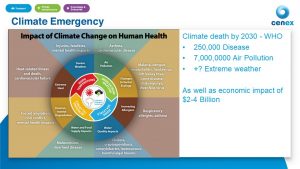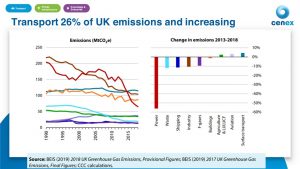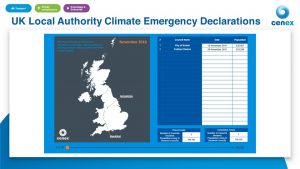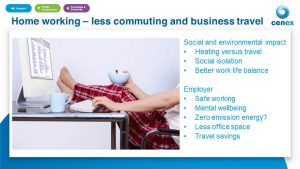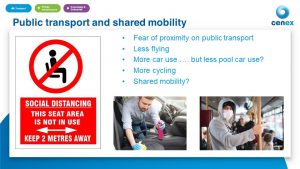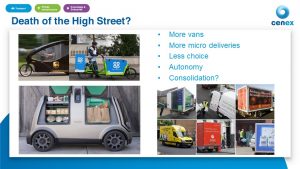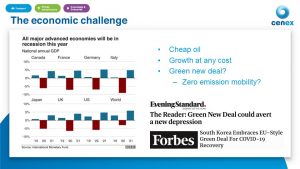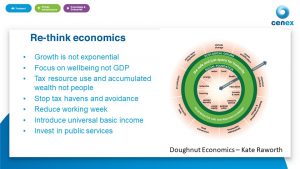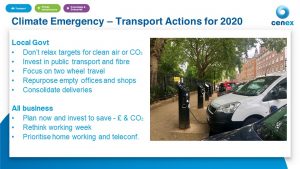
- Categories:
- News
- /
- Announcement
Transport in a climate emergency: Keeping emissions low after Covid-19
Adapting to the Coronavirus crisis has seen pollution levels drop in many UK cities.
In this webinar, Keith Budden looks at the role of transport in a climate emergency and how you can keep emissions down following the pandemic.
Climate Emergency
Before COVID-19 hit, climate change was one of the main topics on the news. We heard about the different impacts nearly every day, but since then it’s disappeared. As humans we are particularly good at understanding and reacting to short-term impacts – the threat of a loaded gun or Coronavirus – rather than the long-term impacts such as unhealthy lifestyles and the gradual increasing risks that climate change brings upon us.
It is quite clear in the figures from the Human Health Organisation that actually the impact of climate change is more significant and extreme than the current challenge we face. This includes increases in mortality due to increase levels of disease, food shortages and extreme weather as well as the 7 million annual early deaths as a result of poor air quality.
The impacts of climate change are huge however they could be forgotten in the crisis we currently face and in our desire to return to normal life.
Transport 26% of emissions and increasing
Transport is now the most significant climate change challenge. Surface transport emissions have remained constant, whilst transport movements have increased, primarily because we are travelling more (in heavier vehicles). We are also having more freight delivered which outweighs the carbon efficiency improvements in vehicles. It is a challenge we need to face.
At Cenex we have a lot of experience in the electrification of vehicles and charging infrastructure as well as hydrogen and biofuels – the transition is possible.
UK Local Authority Climate Emergency Declarations
You can see here that local governments across the UK have increasingly declared climate emergencies, with the so called Greta-effect and pressure from Extinction Rebellion, but many don’t have targets or plans in place and only have a limited understanding of what they have signed up to.
There is a lot that can be done, and Cenex have already provided support to local authorities on their own fleet and business travel, these are areas that can be tackled now with cost benefits. Local authorities can use this time to focus on transport solutions after lockdown such as active travel, and zero emission bus and taxi programmes
Himalaya Mountains visible for first time in 30 years
We are starting to realise some of the positive impacts of lockdown: clean air, less CO2, less noise. Going out on your bike is now a pleasure with less congestion and less traffic. People are seeing the benefits and the delights of having fewer vehicles on the roads. Hearing birds again!
There are around 40,000 premature deaths in the UK each year due to air quality. Not all will be cured by this lockdown, but more people are now aware of the impacts of cleaner air, in particular in our cities, and it is clear that vehicle emissions are the main cause. It is believed that there are a higher number of COVID-19 cases in areas of poor air quality, but it may well be because these areas have a higher population density as well as population with more respiratory disease.
Home working
During lockdown we are seeing more teleconferencing, sometimes four or five teleconferences a day, and people are getting creative with the technology. I think we are seeing the trends that were already there are happening more quickly, so more teleconferencing, more home deliveries, and that is now becoming the norm.
Before I could easily spend £120 on an early morning train to London for a 3 hour meeting, taking 6 hours of travel time which is all evidently now unnecessary. Video conferencing is more efficient and convenient. We will still want to travel but it is inevitable we will move into an era of more home working and more use of video conferencing.
Home working – less commuting and business travel
The impacts are not always positive. Is it better for the environment? Is it better for mental health? The work life balance is difficult, and we are learning to do this in different ways it is not always better to work from home or in isolation
If it’s a cold day you might have your heating on, or if you previously walked or cycled to work, then the carbon impact from home working could be worse than from an office.
Employers should start thinking about the money saved in travel costs and less use of office space – will it be shared with employees to reduce the cost of working from home? Meanwhile employees are potentially saving money from less commuting.
Public Transport and shared mobility
I think the main challenge we will face in terms of public transport and shared mobility use will be the fear of proximity and exposure to Covid-19. Will people want to sit next to strangers on trains, buses or planes?
We are hearing now of airlines not using the middle seat to encourage people back into planes. Train companies are already saying they do not expect the same level of peak business use, they think commuting will go down so are revisiting their business cases. Bus travel will be another challenge; we are expecting to see increase in car use as people self-isolate in their own vehicle rather than public transport. Managing this going forward will be a real challenge. Staggered working hours could be a reality along with a requirement for all those that can to continue working from home.
There are also challenges around shared mobility with increased costs associated with car clubs in terms of cleaning between each use and the cleaning of shared bikes and scooters. We do need to think about how we invest and to re-regulate bus travel to promote electrification and to encourage people back into safe and pleasant travel on public transport.
Death of the High Street?
Clearly home delivery is an increasing trend, but small shops and independents are suffering as they do not have the resources to adapt and compete with larger supermarkets who already have home delivery services. The impact on the small shops and the high street will be significant as we anticipate many people will continue to have their main shops delivered, and use the high street less
We are already seeing a decline on the high-street which I fear will continue as a trend. More shops are delivering but we need to consolidate that in micro-delivery. There is the potential for more autonomy as it has less human contact; it still needs to be worked out but it is a trend we could see taking off in some areas. Milton Keynes is already testing autonomous deliveries.
The challenge will be to keep the pressure on zero emission deliveries, especially now many supermarkets may not be considering emissions as they rapidly increase the number of vans doing deliveries – unless they are operating around clean air zones – so it’s important we don’t relax those targets.
The economic challenge
Transport is primarily a service to the economy, delivering raw materials and workers and supplying customers with goods and services.
Congestion and fuel costs are a constraint on the economy whereas investing in transport infrastructure enables people to get to work and goods to customers more quickly and effectively
I think how we look at the economy will affect how we look at transport post Covid-19. There are two world views and I think they will contrast: one view of relaxed regulation to stimulate growth and to cut back on public expenditure, so relax regulation to stimulate growth; followed by another world view on the strength of regulation with particular focus on climate regulation and clean air, and to invest in green growth and provide economic incentives.
Re-think Economics
How do we make sure we live with to deliver minimum social benefits without poverty and also live within environmental limits knowing that we don’t have endless resources, at a local and national global level?
Spain has just introduced a universal basic income; Denmark has announced they will not provide financial support for companies registered off shore. This all comes back to economics being a view of politics, and how transport can be a lever for economic and social development but within environmental limits – we cannot all own a Tesla!
Climate emergency – Transport actions for 2020
Firstly, it is critical that we remember that climate change is a bigger threat than COVID-19, a longer-term threat but a real threat. We shouldn’t underestimate the impact of air quality – the 40,000 premature deaths as a result of poor air quality each year in the UK is something we can tackle; transport is an obvious area we can improve so it’s important we remain strong on current emission targets, despite the economic downturn.
Dealing with the challenge of social distancing on public transport can be solved by investing and bringing buses back into more local control and running services to meet people’s needs – on demand, bookable transit. There is also a huge opportunity to promote micro-mobility for those people who do not want to use buses for fear of exposure.
One of the big opportunities for local government is to think about the use of empty office premises and shops as people move to home working and online shopping. We can repurpose shops and office buildings into homes, increase population density within cities which reduces some of the needs to travel.
Businesses can start to rethink the working week, setting targets for home working and focus on reducing the need and cost for business travel to save money and emissions.
Get in touch to see how you can lower your emissions.
Download the slides here. For a video copy of the webinar email: marketing@cenex.co.uk
